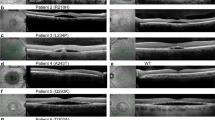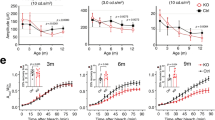Abstract
Lipid metabolic deficiencies are associated with many genetic disorders. Bietti crystalline dystrophy (BCD), a blindness-causing inherited disorder with changed lipid profiles, is more common in Chinese and Japanese than other populations. Our results reveal that mouse models lacking Cyp4v3 have less physiological and functional changes than those of BCD patients with this gene defect. After the administration of a high-fat diet (HFD), the occurrence of retinal lesions were both accelerated and aggregated in the Cyp4v3−/− mouse models, implying that changed lipid levels were not only associated factors but also risk factors to BCD patients. Facilitated by the results, we found that the reduced electroretinography waveforms and retinal thickness observed in the HFD-induced mouse models were effectively recovered after subretinal delivery of a human CYP4V2 gene carried by an adeno-associated virus vector, which demonstrates the potential curability of BCD by gene therapy.
This is a preview of subscription content, access via your institution
Access options
Subscribe to this journal
Receive 12 print issues and online access
$259.00 per year
only $21.58 per issue
Buy this article
- Purchase on Springer Link
- Instant access to full article PDF
Prices may be subject to local taxes which are calculated during checkout






Similar content being viewed by others
References
Friedmann T, Roblin R. Gene therapy for human genetic disease? Science. 1972;175:949–55.
Mckusick VA. Mendelian inheritance in man and its online version, omim. Am J Hum Genet. 2007;80:588–604.
Chen R, Shi LS, Hakenberg J, Naughton B, Sklar P, Zhang JG, et al. Analysis of 589,306 genomes identifies individuals resilient to severe mendelian childhood diseases. Nat Biotechnol. 2016;34:531–8.
Dunbar CE, High KA, Joung JK, Kohn DB, Ozawa K, Sadelain M. Gene therapy comes of age. Science. 2018;359:eaan4672.
Ginn SL, Amaya AK, Alexander IE, Edelstein M, Abedi MR. Gene therapy clinical trials worldwide to 2017: an update. J Gene Med. 2018;20:e3015.
Casal M, Haskins M. Large animal models and gene therapy. Eur J Hum Genet. 2006;14:266–72.
Bietti GB. Ueber familiaeres vorkommen von “ retinitis punctata albescens”(verbunden mit “dystrophia marginalis cristallinea corneae”): Glitzern des glaskoerpers und anderen degenerativen augenveraenderungen. Klin Mbl Augenheilk. 1937;99:737–56.
Jiao XD, Munier FL, Iwata F, Hayakawa M, Kanai A, Lee J, et al. Genetic linkage of bietti crystallin corneoretinal dystrophy to chromosome 4q35. Am J Hum Genet. 2000;67:1309–13.
Hu DN. Ophthalmic genetics in china. Ophthalmic Paed Gen. 1983;2:39–45.
Li A, Jiao X, Munier FL, Schorderet DF, Yao W, Iwata F, et al. Bietti crystalline corneoretinal dystrophy is caused by mutations in the novel gene cyp4v2. Am J Hum Genet. 2004;74:817–26.
Kaiser-Kupfer MI, Chan C-C, Markello TC, Crawford MA, Caruso RC, Csaky KG, et al. Clinical biochemical and pathologic correlations in bietti’s crystalline dystrophy. Am J Ophthalmol. 1994;118:569–82.
Lai TYY, Chu KO, Chan KP, Ng TK, Yam GHF, Lam DSC, et al. Alterations in serum fatty acid concentrations and desaturase activities in bietti crystalline dystrophy unaffected by cyp4v2 genotypes. Investig Ophth Vis Sci. 2010;51:1092–7.
Hata M, Ikeda HO, Iwai S, Iida Y, Gotoh N, Asaka I, et al. Reduction of lipid accumulation rescues bietti’s crystalline dystrophy phenotypes. Proc Natl Acad Sci USA. 2018;115:3936–41.
Lockhart CM, Nakano M, Rettie AE, Kelly EJ. Generation and characterization of a murine model of bietti crystalline dystrophy. Investig Ophth Vis Sci. 2014;55:5572–81.
Li W, Teng F, Li T, Zhou Q. Simultaneous generation and germline transmission of multiple gene mutations in rat using crispr-cas systems. Nat Biotechnol. 2013;31:684–6.
Fernandez-Godino R, Garland DL, Pierce EA. Isolation, culture and characterization of primary mouse rpe cells. Nat Protoc. 2016;11:1206–18.
Lam SM, Tong L, Duan X, Petznick A, Wenk MR, Shui G. Extensive characterization of human tear fluid collected using different techniques unravels the presence of novel lipid amphiphiles. J Lipid Res. 2014;55:289–98.
Tomono T, Hirai Y, Okada H, Miyagawa Y, Adachi K, Sakamoto S, et al. Highly efficient ultracentrifugation-free chromatographic purification of recombinant aav serotype 9. Mol Ther. 2018;11:180–90.
Grieger JC, Soltys SM, Samulski RJ. Production of recombinant adeno-associated virus vectors using suspension hek293 cells and continuous harvest of vector from the culture media for gmp fix and flt1 clinical vector. Mol Ther. 2016;24:287–97.
Ai J, Ibraheim R, Tai PWL, Gao G. A scalable and accurate method for quantifying vector genomes of recombinant adeno-associated viruses in crude lysate. Hum Gene Ther Methods. 2017;28:139–47.
Meng XH, Guo H, Xu HW, Li QY, Jin X, Bai Y, et al. Identification of novel cyp4v2 gene mutations in 92 chinese families with bietti’s crystalline corneoretinal dystrophy. Mol Vis. 2014;20:1806–14.
Xiao X, Mai G, Li S, Guo X, Zhang Q. Identification of cyp4v2 mutation in 21 families and overview of mutation spectrum in bietti crystalline corneoretinal dystrophy. Biochem Biophys Res Commun. 2011;409:181–6.
Rossi S, Testa F, Li A, Yaylacioglu F, Gesualdo C, Hejtmancik JF, et al. Clinical and genetic features in italian bietti crystalline dystrophy patients. Br J Ophthalmol. 2013;97:174–9.
Wilson DJ, Weleber RG, Klein ML, Welch RB, Green WR. Bietti’s crystalline dystrophy: a clinicopathologic correlative study. JAMA Ophthalmol. 1989;107:213–21.
Halford S, Liew G, Mackay DS, Sergouniotis PI, Holt R, Broadgate S, et al. Detailed phenotypic and genotypic characterization of bietti crystalline dystrophy. Ophthalmology. 2014;121:1174–84.
Benchorin G, Calton MA, Beaulieu MO, Vollrath D. Assessment of murine retinal function by electroretinography. Bio Protoc. 2017;7:e2218.
Lee J, Jiao X, Hejtmancik JF, Kaiser-Kupfer M, Gahl WA, Markello TC, et al. The metabolism of fatty acids in human bietti crystalline dystrophy. Investig Ophthalmol Vis Sci. 2001;42:1707–14.
Acland GM, Aguirre GD, Ray J, Zhang Q, Aleman TS, Cideciyan AV, et al. Gene therapy restores vision in a canine model of childhood blindness. Nat Genetics. 2001;28:92–5.
Maeder ML, Stefanidakis M, Wilson CJ, Baral R, Barrera LA, Bounoutas GS, et al. Development of a gene-editing approach to restore vision loss in leber congenital amaurosis type 10. Nat Med. 2019;25:229–33.
Daya S, Berns KI. Gene therapy using adeno-associated virus vectors. Clin Microbiol Rev. 2008;21:583–93.
Mingozzi F, High KA. Immune responses to aav in clinical trials. Current Gene Ther. 2007;7:316–24.
Bankiewicz KS, Forsayeth J, Eberling JL, Sanchez-Pernaute R, Pivirotto P, Bringas J, et al. Long-term clinical improvement in mptp-lesioned primates after gene therapy with aav-haadc. Mol Ther. 2006;14:564–70.
Choi VW, Mccarty DM, Samulski RJ. Host cell DNA repair pathways in adeno-associated viral genome processing. J Virol. 2006;80:10346–56.
Nathwani AC, Reiss UM, Tuddenham EG, Rosales C, Chowdary P, Mcintosh J, et al. Long-term safety and efficacy of factor ix gene therapy in hemophilia b. N Engl J Med. 2014;371:1994–2004.
Nathwani AC, Tuddenham EG, Rangarajan S, Rosales C, Mcintosh J, Linch DC, et al. Adenovirus-associated virus vector-mediated gene transfer in hemophilia b. N Engl J Med. 2011;365:2357–65.
Timmers AM, Zhang H, Squitieri A, Gonzalez-Pola C. Subretinal injections in rodent eyes: effects on electrophysiology and histology of rat retina. Mol Vis. 2001;7:131–7.
Gocho K, Kameya S, Akeo K, Kikuchi S, Usui A, Yamaki K, et al. High-resolution imaging of patients with bietti crystalline dystrophy with cyp4v2 mutation. J Ophthalmol. 2014;2014:283603.
Zhao H, Li Y, He L, Pu W, Yu W, Li Y, et al. In vivo aav-crispr/cas9-mediated gene editing ameliorates atherosclerosis in familial hypercholesterolemia. Circulation. 2020;141:67–79.
Acknowledgements
We thank Shi-Wen Li, Xi-Li Zhu for their help with confocal laser scanning microscope.
Funding
This work was supported by the National Key Research and Development Program (2019YFA0110800 to WL, 2017YFA0103803 to QZ); the Key Research Program of the Chinese Academy of Sciences (KJZD-SW-L03); the Strategic Priority Research Program of the Chinese Academy of Sciences (XDA16030403 to WL); the National Natural Science Foundation of China (31621004 to QZ and WL); the Key Research Projects of the Frontier Science of the Chinese Academy of Sciences (QYZDY-SSW-SMC002 to QZ, QYZDB-SSW-SMC022 to WL); the National Postdoctoral Program for Innovative Talents (BX201600161 to ZL); the Beijing Natural Science Foundation (7184236 to XZ);the Non-profit Central Research Institute Fund of Chinese Academy of Medical Sciences (2018PT32029 to R.S.); the Chinese Ministry of Science and Technology (2010DFB33430).
Author information
Authors and Affiliations
Contributions
WL, RS, and QZ conceived the project and designed the experiments; BQ, SW, GJ, ZL, XZ, and LG performed the experiments; BQ and ZL analyzed the data; WL, YZ, and BQ wrote the manuscript with the assistance of the other authors.
Corresponding authors
Ethics declarations
Conflict of interest
The authors declare that they have no conflict of interest.
Additional information
Publisher’s note Springer Nature remains neutral with regard to jurisdictional claims in published maps and institutional affiliations.
Rights and permissions
About this article
Cite this article
Qu, B., Wu, S., Jiao, G. et al. Treating Bietti crystalline dystrophy in a high-fat diet-exacerbated murine model using gene therapy. Gene Ther 27, 370–382 (2020). https://doi.org/10.1038/s41434-020-0159-3
Received:
Revised:
Accepted:
Published:
Issue Date:
DOI: https://doi.org/10.1038/s41434-020-0159-3
This article is cited by
-
Longitudinal structure-function analysis of molecularly-confirmed CYP4V2 Bietti Crystalline Dystrophy
Eye (2024)
-
In vivo genome editing via CRISPR/Cas9-mediated homology-independent targeted integration for Bietti crystalline corneoretinal dystrophy treatment
Nature Communications (2024)
-
Gene replacement therapy in Bietti crystalline corneoretinal dystrophy: an open-label, single-arm, exploratory trial
Signal Transduction and Targeted Therapy (2024)
-
Clinical and genetic characterization of a large cohort of Chinese patients with Bietti crystalline retinopathy
Graefe's Archive for Clinical and Experimental Ophthalmology (2024)
-
A patient advocating for transparent science in rare disease research
Orphanet Journal of Rare Diseases (2023)



